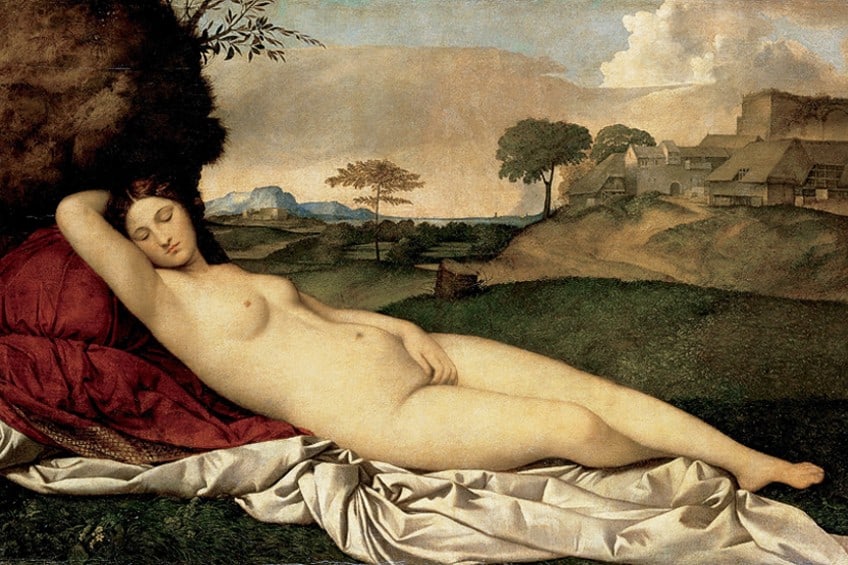Sfumato – Discover the Style of the Sfumato Technique
What is sfumato? And when did this technique first appear in art history? Often used to represent smooth and seamless gradations, the sfumato technique has been adopted by many legendary artists, including Leonardo da Vinci, Correggio, and Giorgione. In this article, we will introduce you to all you need to know about this remarkable technique, including a sfumato definition with various examples from Renaissance paintings that will help you fully grasp the method. Keep reading to learn more about the delicate process of sfumato!
Contents
- 1 Exploring Sfumato: Seamless Gradations in Oil Painting
- 2 Sfumato Examples in Renaissance Art
- 2.1 Portrait of a Man (1508 – 1510) by Titian
- 2.2 Sleeping Venus (1508 – 1510) by Giorgione and Titian
- 2.3 Transfiguration (1516 – 1520) by Raphael
- 2.4 Virgin and Child between St Francis of Assisi and St John the Evangelist (1517) by Andrea del Sarto
- 2.5 Assumption of the Virgin (1526 – 1530) by Antonio da Correggio
- 3 Frequently Asked Questions
Exploring Sfumato: Seamless Gradations in Oil Painting
During the Renaissance, the arts saw a boom in the development of different painting techniques, which included four primary methods: sfumato, chiaroscuro, cangiante, and unione. The sfumato technique was used by a selection of leading artists from the Renaissance, including Leonardo da Vinci and Federico Barocci, who all used the technique to create timeless masterpieces. Below, we will explore the sfumato method, which emerged from the Italian word fumo and translates in English to “smoke”.
We will also look at a few famous sfumato examples and sfumato artists that will provide you with a comprehensive understanding of the technique and how it can be used in oil painting.
A Sfumato Definition
So what is sfumato? Sfumato is a method applied in oil painting whereby the artist blends the colors of the paintings subtly to achieve a smooth transition or gradation between different colors. These tones are blended so seamlessly that it becomes hard to perceive the brushstrokes of the work and makes the composition appear realistic.
In the 15th century, Da Vinci described his sfumato definition as a process where the artist blended the colors “without lines or borders” and compared the result of the technique to the same way that smoke moves – effortlessly.

The visual aesthetic of the smoke was also important to the final painting since the painting should appear as though there was a veil of smoke between the viewer and the painting. The brighter areas of the painting would be toned down and the darker areas would be lightened, such that the artwork appears to have a smoky and soft filter over it with seamless transitions between lines, colors, and edges.
A History of Sfumato in Art
So when did this technique make its debut in art history? It is speculated that the sfumato method was first discovered at an early Flemish school, which housed artists such as Rogier Van Der Weyden and Jan Van Eyck. The sfumato technique was a major painting method of the Renaissance that had its roots in early Christian painting and was featured in works such as Leonardo da Vinci’s Madonna of the Rocks (1483 – 1485), which was created for a chapel at the San Francesco Grande.
A similar approach to creating tonal gradations was also used in ancient Greece and Rome, which was speculated to perhaps be the birthplace of sfumato. The artists of antiquity used a method called skiagraphia, which was used to create a sense of volume and depth in painting.
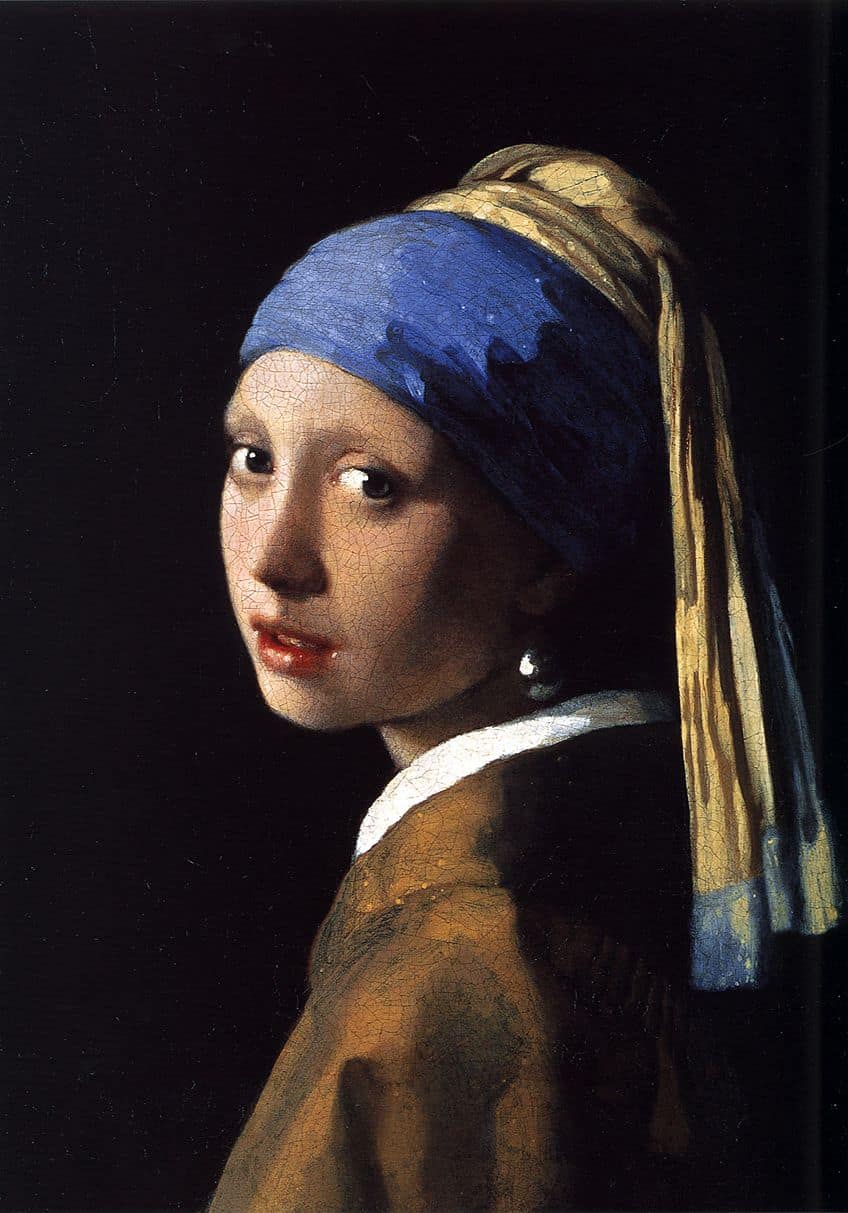
While the origins of the sfumato method remain unclear, it has been closely credited to Leonardo da Vinci and connected to additional works from 15th-and-16th-centuries Italy. Da Vinci is credited with popularizing the sfumato method, which produced atmospheric and hazy visual effects as seen in other works such as the Mona Lisa (1503). It was believed that Da Vinci incorporated sfumato to add a sense of depth, atmosphere, and volume to his paintings. The hazy effect was also achieved by using multiple layers of paint, which we will discuss below.
Regardless of the original inventor, the history of sfumato proved to be highly influential and had a profound impact on many Renaissance masters across France and the Netherlands.
Sfumato as Practiced by Leonardo Da Vinci
How does one execute sfumato? Sfumato involves the use of multiple translucent glazes that produces a gradual tonal range, transitioning color values from dark to light. For example, Leonardo da Vinci used sfumato by applying numerous thin layers of paint that he gradually built upon to produce smooth and subtle transitions. He used sfumato in conjunction with a technique called blending, where he used his finger or brush to blend and soften the harsh edges of aspects of the painting that he needed to smoothen.
Da Vinci expertly achieved the technique in Madonna of the Rocks where he portrayed the Virgin Mary as a glowing figure to highlight the idea of an immaculate conception and emphasize Mary’s innocence and grace.
The painting was commissioned by the Franciscan Confraternity of the Immaculate Conception, who were allegedly involved in a debate with the Dominicans concerning the conception of the Virgin. As such, Da Vinci was tasked with illustrating Mary as “crowned” with the “living light” and without any sense of shadow. He also added a cave background, which made Da Vinci’s sfumato approach stand out and expressed Mary’s figure as emerging from the shadows.
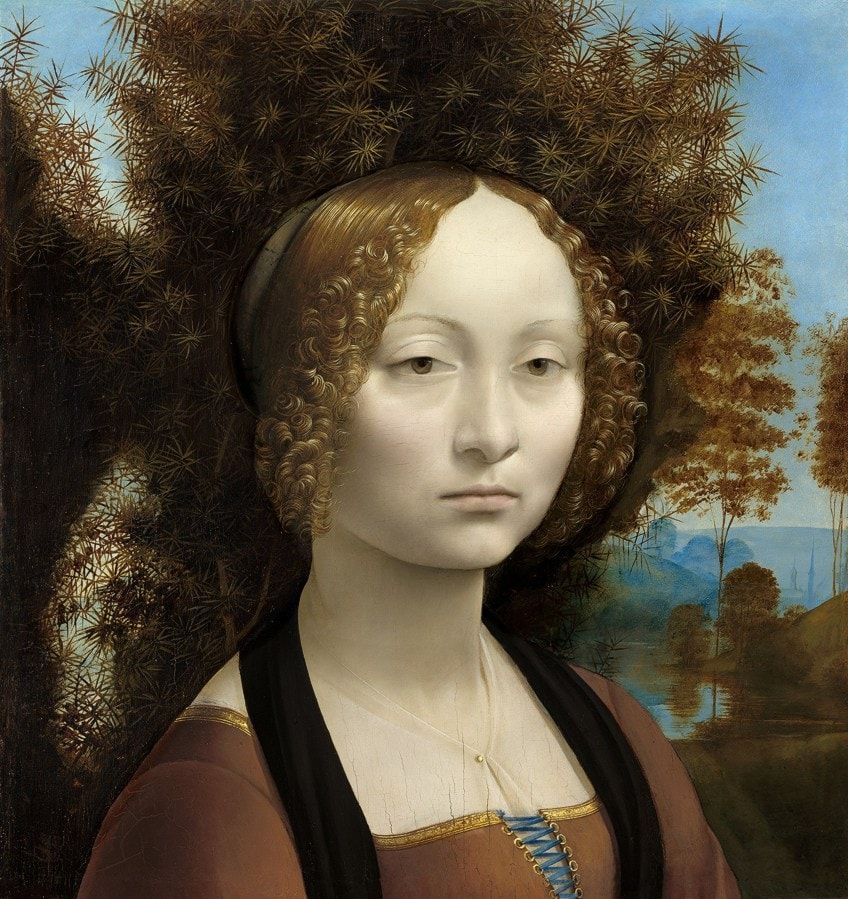
Physicists Pascal Cotte and Mady Elias virtually revealed the true painterly quality of the Mona Lisa in 2008 after they removed the heavy layer of varnish and used a multi-spectral camera to explore how the sfumato technique was achieved. It was discovered that the technique was achieved using multiple layers of one pigment that comprised 99% lead white and 1% vermillion. In 2010, a quantitative study was performed by de Viguerie and colleagues who conducted a non-invasive X-ray fluorescence spectrometry examination on a few other paintings by Da Vinci and found that over time, Da Vinci was practicing the technique leading up to his best-achieved version of it in the Mona Lisa.
After the Mona Lisa, Da Vinci further developed the technique using an organic medium in his translucent glazes, which he applied in micro-thin layers to his works.
Researchers also used direct optical microscopy to reveal that Da Vinci managed to create flesh tones using sfumato by superimposing four layers. These included one priming layer made up of lead white pigment, a second layer made up of a combination of earth, lead white, and vermillion, a third layer acting as a shadow glaze and comprising opaque paint mixed with dark colors, and lastly, a varnish as the fourth layer. Each layer was extremely thin and measured between 10 and 50 microns in thickness. Leonardo da Vinci was thus the most famous sfumato artist credited with developing and popularizing the technique.
Sfumato Examples in Renaissance Art
Now that you have an understanding of the history and use of sfumato, you can now enjoy a selection of sfumato artworks produced by other renowned Renaissance sfumato artists! Included in the list below are artists such as Antonio da Correggio, Raphael, and Andrea del Sarto.
Portrait of a Man (1508 – 1510) by Titian
| Artist Name | Tiziano Vecelli (Professionally known as Titian) (c. 1485/1490 – 1576) |
| Date | 1508 – 1510 |
| Art Period | High Renaissance |
| Medium | Oil on canvas |
| Dimensions (cm) | 59.7 x 47 |
| Where It Is Housed | Indianapolis Museum of Art at Newfields, Indiana, United States |
Titian, also known as Tiziano Vecelli, was one of the greatest High Renaissance oil painters in art history whose use of the sfumato technique helped influence many throughout his generation. Portrait of a Man is one of many portraits of men created by Titian in the early 16th century and is a great sfumato art example to study. The painting demonstrates Titian’s expert hand at introducing color alongside light in a controlled manner while delivering an atmospheric visual quality.
In addition to creating seamless transitions between his sitter’s face and hair, he also presented a balance between light and shadow, which brought a sense of dimension and structure to the sitter’s face.
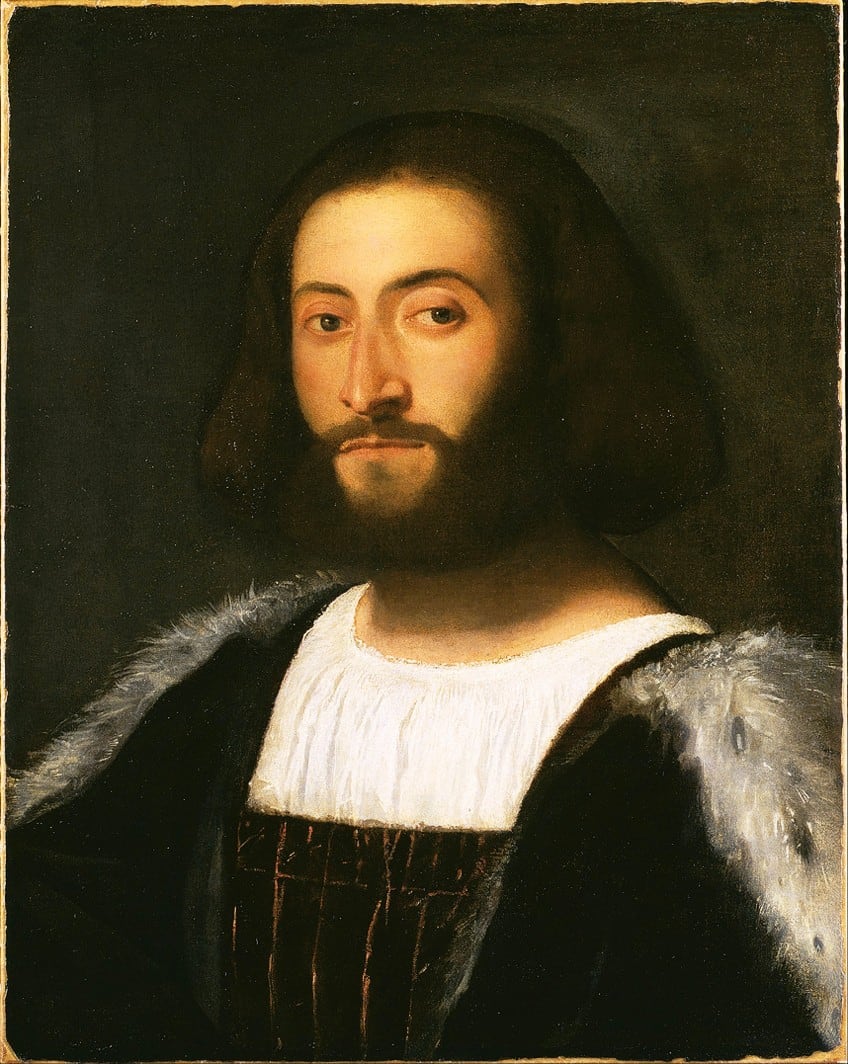
Titian’s application of sfumato can be admired in the way he used it to model the sitter’s face and softly blend the colors around the man’s nose and eyes. Sfumato can also be seen on the man’s clothing as Titian carefully painted the texture of the garment to add a sense of weight to his clothes. The emotional impact of the portrait is to be admired for its sense of immediacy, which is illustrated by the man’s face, which appears to emerge from the soft fringes of the painting.
Sleeping Venus (1508 – 1510) by Giorgione and Titian
| Artist Name | Giorgione (1477 – 1510) and Tiziano Vecelli (Professionally known as Titian) (c. 1485/1490 – 1576) |
| Date | 1508 – 1510 |
| Art Period | High Renaissance, Italian Renaissance, and Venetian painting |
| Medium | Oil on canvas |
| Dimensions (cm) | 108.5 x 175 |
| Where It Is Housed | Old Masters Picture Gallery, Dresden State Art Museums, Dresden, Germany |
Sleeping Venus is a famous sfumato painting created by Giorgione and Titian between 1508 and 1510. Giorgione was best known for his affiliation with the Venetian school and as a great master of the High Renaissance whose paintings were celebrated as poetic masterpieces.
Sleeping Venus portrays a nude woman reclining in a bed and partially covered by drapery.

Here, Giorgione and Titian used the sfumato technique to emphasize the sensuality and eroticism of the woman by accentuating the soft hazy atmosphere, thus making the scene feel more like a dream. The painting is also incredibly stunning in its depiction of sensual vulnerability, which is complemented by the artist’s expert hand in the blending of shadows with the edges of the woman’s skin.
Transfiguration (1516 – 1520) by Raphael
| Artist Name | Raffaello Sanzio da Urbino (1483 – 1520) |
| Date | 1516 – 1520 |
| Art Period | High Renaissance Christian art |
| Medium | Oil tempera on wood |
| Dimensions (cm) | 410 x 279 |
| Where It Is Housed | Vatican Museums, Vatican City, Italy |
Born Raffaello Sanzio da Urbino, Raphael was an incredibly talented Italian painter of the High Renaissance who is most famous for his masterpiece works at Vatican City. As with many great painters of his era, Raphael also used the sfumato method to produce iconic works such as Transfiguration and Madonna del Prato (c. 1505). Raphael’s approach to oil painting was characterized by his skillful curation of balance and harmony in his compositions as well as the sfumato technique to add a sense of grace.
Transfiguration is one of Raphael’s best sfumato-styled paintings that presents a dramatic scene featuring the defeat of the devil and was considered to be a prefiguration of the Last Judgment.
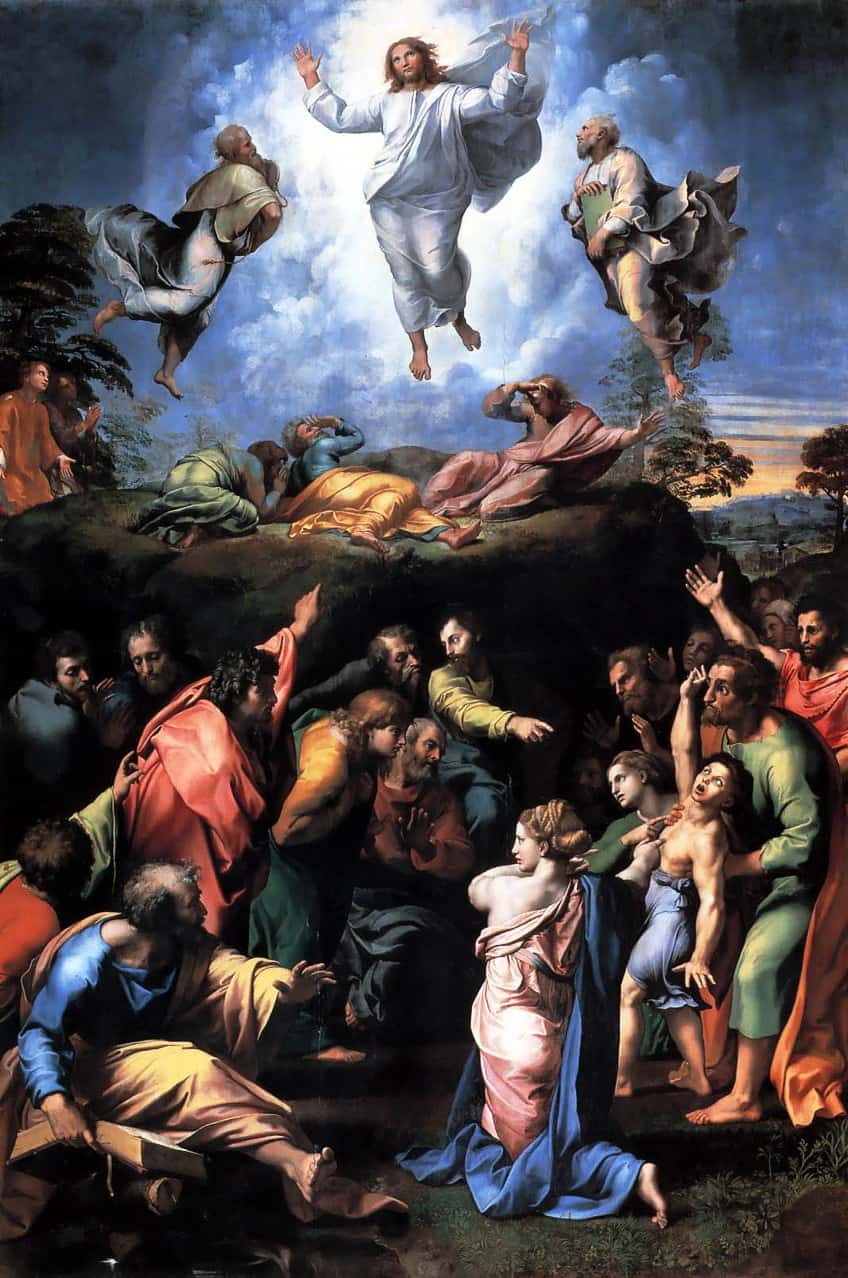
Raphael also used sfumato to unify the composition and depict Christ as a divine figure descending from the endless skies. His radiant appearance is what makes the painting stand out and amplifies the holy nature of the artwork that commands reverence. Sfumato was therefore an excellent painting method for religious artworks of the Renaissance since its effect helped promote not only the artists who mastered it but also the iconography of the church.
Virgin and Child between St Francis of Assisi and St John the Evangelist (1517) by Andrea del Sarto
| Artist Name | Andrea d’Agnolo (Professionally known as Andrea del Sarto) (1486 – 1530) |
| Date | 1517 |
| Art Period | Mannerism and High Renaissance |
| Medium | Oil on panel |
| Dimensions (cm) | 207 x 178 |
| Where It Is Housed | Uffizi Gallery, Florence, Italy |
Dubbed “the flawless painter” by Giorgio Vasari, Andrea del Sarto was one of the best sfumato artists of the 16th century who used sfumato in many of his most iconic works, including Virgin and Child between St Francis of Assisi and St John the Evangelist, which is also recognized as the Madonna of the Harpies. The sfumato-style painting was created in 1517 as a commissioned artwork for the convent of St. Francis de Macci.
Aside from the painting’s detailed composition and pyramidal shape cast by the Madonna and angels, it is known as one of the best examples of sfumato.
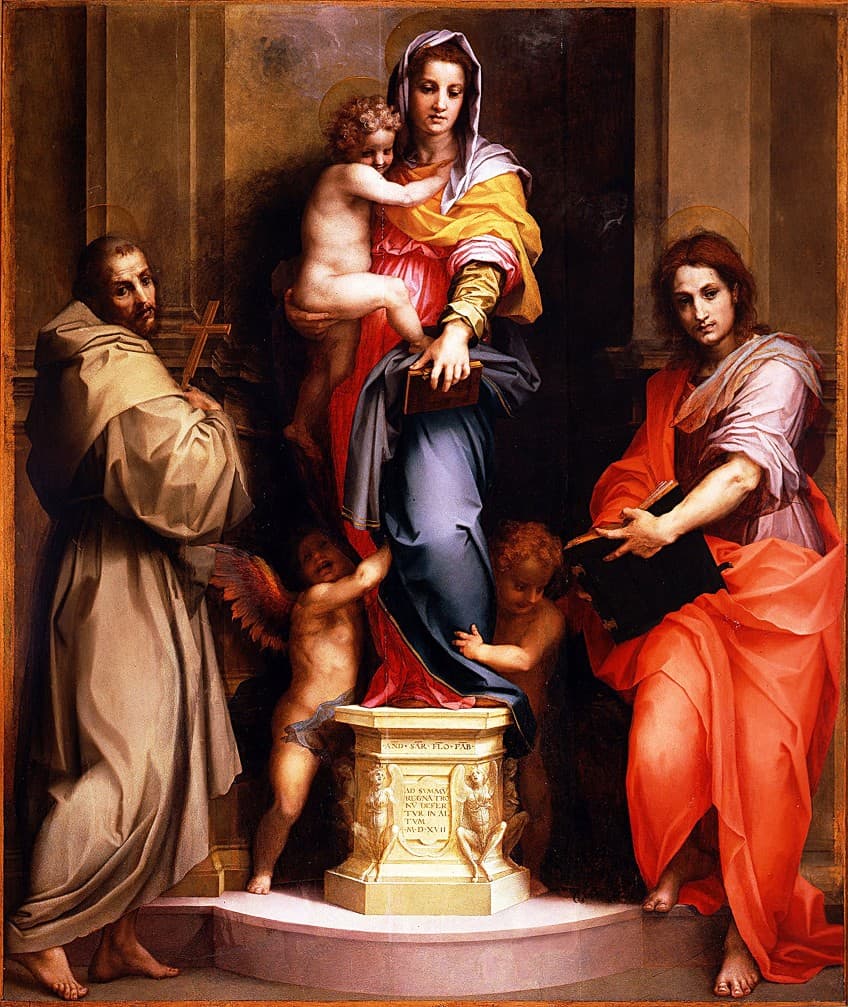
Here, Sarto used sfumato to soften the edges of the figures such that the focal point is drawn to the Madonna who is encapsulated by a darker background. The sfumato effect also shows off the tender nature of the relationship between Madonna and the infant Jesus while being most prominent in her hair and face. Sarto’s delicate handling of the paint to create a subtle sense of depth is also a key highlight of the painting.
Assumption of the Virgin (1526 – 1530) by Antonio da Correggio
| Artist Name | Antonio Allegri da Correggio (1489 – 1534) |
| Date | 1526 – 1530 |
| Art Period | High Italian Renaissance |
| Medium | Fresco |
| Dimensions (cm) | 110 x 120 |
| Where It Is Housed | Cattedrale di Parma, Parma, Italy |
The Assumption of the Virgin is among the most famous sfumato art examples of the Italian High Renaissance, which was created by Antonio da Correggio. Correggio was celebrated as an icon of sfumato painting who knew how to leverage the technique to produce a sense of movement and delicate transitions between the light and dark aspects of his compositions as seen in Assumption of the Virgin.
The fresco was created for the Cathedral of Parma in Italy in the 16th century and showcases Correggio’s mastery of sfumato in illusionistic ceiling painting.
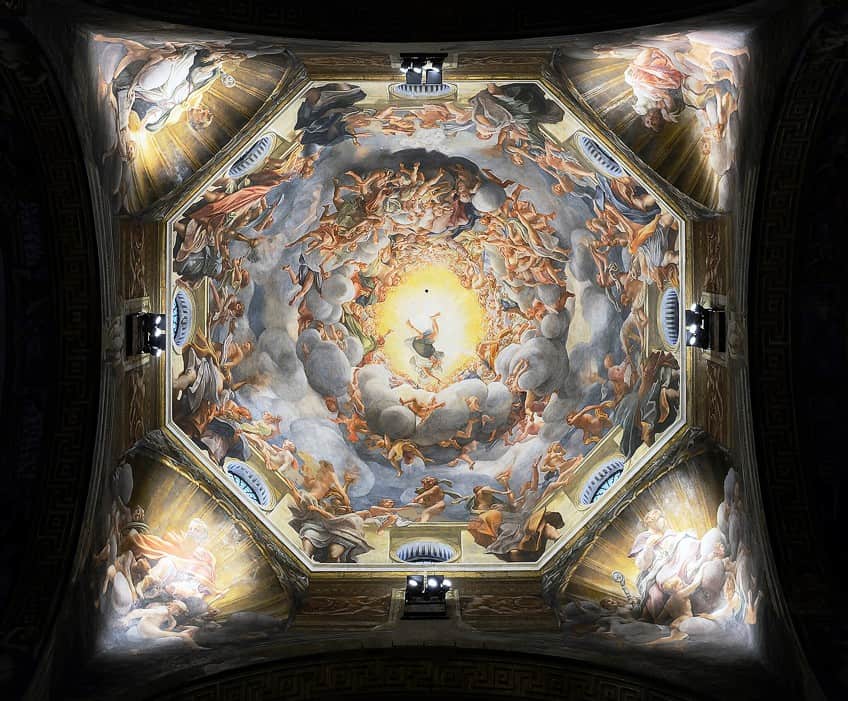
Together with another technique, which he pioneered called di sotto in sù, Correggio created a spectacular illusion of Mary and the apostles blending in with the floating clouds as the viewer inspects the fresco from the ground up. Correggio proved to be an incredibly influential artist who went on to inspire many French Impressionist and Modern artists with his unique view and technical approach to representing mythological and religious subjects.
The sfumato technique was crucial to the artistic development of old masters and their iconic Renaissance paintings, which demonstrated the power of continuous learning in one’s art practice. The technique also enabled many artists to create a sense of atmosphere, depth, and three-dimensional illusions in oil painting, which resulted in many of the world’s most loved paintings from art history!
Take a look at our what is sfumato webstory here!
Frequently Asked Questions
What Is Sfumato?
Sfumato is an oil painting technique that emerged in the early Renaissance period and was applied to gradually shade and soften harsh edges and outlines in artworks to create an atmospheric or hazy effect. Sfumato is said to mimic the appearance of the out-of-focus plane and was one of the four major techniques used in Renaissance painting.
Who Is the Most Famous Sfumato Artist?
The most famous sfumato artist is recognized as Leonardo da Vinci, who used the Renaissance painting technique to create many famous paintings, including the Mona Lisa (1503). Da Vinci was motivated to pursue sfumato in his painting after studying human optics, notions of the camera obscura, and human vision.
When Did the Sfumato Method Originate?
The sfumato method is theorized to have originated in the 14th century, during the early Italian Renaissance, and was believed to have been practiced by a Flemish school.
Liam Davis is an experienced art historian with demonstrated experience in the industry. After graduating from the Academy of Art History with a bachelor’s degree, Liam worked for many years as a copywriter for various art magazines and online art galleries. He also worked as an art curator for an art gallery in Illinois before working now as editor-in-chief for artfilemagazine.com. Liam’s passion is, aside from sculptures from the Roman and Greek periods, cave paintings, and neolithic art.
Learn more about Liam Davis and about us.
Cite this Article
Liam, Davis, “Sfumato – Discover the Style of the Sfumato Technique.” artfilemagazine – Your Online Art Source. April 25, 2023. URL: https://artfilemagazine.com/sfumato/
Davis, L. (2023, 25 April). Sfumato – Discover the Style of the Sfumato Technique. artfilemagazine – Your Online Art Source. https://artfilemagazine.com/sfumato/
Davis, Liam. “Sfumato – Discover the Style of the Sfumato Technique.” artfilemagazine – Your Online Art Source, April 25, 2023. https://artfilemagazine.com/sfumato/.


